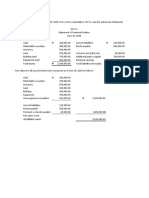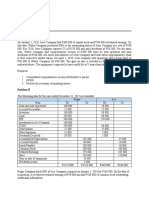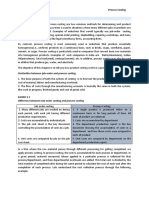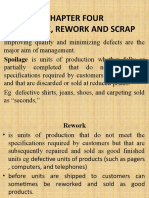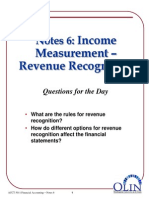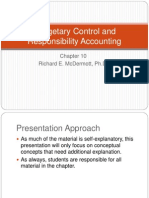Spoilage
Spoilage
Uploaded by
Bhawin DondaCopyright:
Available Formats
Spoilage
Spoilage
Uploaded by
Bhawin DondaOriginal Description:
Copyright
Available Formats
Share this document
Did you find this document useful?
Is this content inappropriate?
Copyright:
Available Formats
Spoilage
Spoilage
Uploaded by
Bhawin DondaCopyright:
Available Formats
Section no. PGP 1 B Roll No.
70 Name: Bhavin Donda Title of the Concept Integration Repot: What are the spoilage, rework and scrap? College: Som-lalit institute of management study Signature of student:
Definition Spoilageunits of production that do not meet the standards required by customers for good units and that are discarded or sold for reduced prices. Reworkunits of production that do not meet the standards required by customers for finished units that are subsequently repaired and sold as acceptable finished units. Scrapmaterial left over when making a product. It has low sales value compared with the sales value of the product.
Some amounts of spoilage, rework, or scrap are inherent in many production processes. For example, semiconductor manufacturing is so complex and delicate that some spoiled units are commonly produced; usually, the spoiled units cannot be reworked. In the manufacture of high-precision machine tools, spoiled units can be reworked to meet standards, but only at a considerable cost. And in the mining industry, companies process ore that contains varying amounts of valuable metals and rock. Some amount of rock, which is scrap, is inevitable.
Spoilage Accounting for spoilage aims to determine the magnitude of spoilage costs and to distinguish between costs of normal and abnormal spoilage To manage, control and reduce spoilage costs, they should be highlighted, not simply folded into production costs
Types of Spoilage Normal Spoilage is spoilage inherent in a particular production process that arises under efficient operating conditions Management determines the normal spoilage rate Costs of normal spoilage are typically included as a component of the costs of good units manufactured because good units cannot be made without also making some units that are spoiled Abnormal Spoilage is spoilage that is not inherent in a particular production process and would not arise under normal operating conditions
Abnormal spoilage is considered avoidable and controllable Units of abnormal spoilage are calculated and recorded in the Loss from Abnormal Spoilage account, which appears as a separate line item no the income statement
Process Costing and Spoilage Units of Normal Spoilage can be counted or not counted when computing output units (physical or equivalent) in a process costing system Counting all spoilage is considered preferable Inspection Points and Spoilage Inspection Point the stage of the production process at which products are examined to determine whether they are acceptable or unacceptable units. Spoilage is typically assumed to occur at the stage of completion where inspection takes place The Five-Step Procedure for Process Costing with Spoilage Example: Mira Company manufactures a recycling container in its forming department. Direct materials are added at the beginning of the production process. Conversion costs are added evenly during the production process. Some units of this product are spoiled as a result of defects, which are detectable only upon inspection of finished units. Normally, spoiled units are 10% of the finished output of good units. That is, for every 10 good units produced, there is 1 unit of normal spoilage. Summary data for July 2012 are as follows:
2 3 4 5 6 7
Work in process, beginning inventory (July 1) Degree of completion of beginning work in process Started during July Good units completed and transferred out during July Work in process, ending inventory (July 31) Degree of completion of ending work in
Physi cal Units (1) 1500
Direct Materials (2) RS.12,000 100%
Conversion Total Costs Costs (3) (4) = (2) + (3) RS.9,000 RS.21,000 60%
8500 7000 2000 100% 50%
8 9 10 11
process Total costs added during July Normal spoilage as a percentage of good units Degree of completion of normal spoilage Degree of completion of abnormal spoilage
RS.76,500 10% 100% 100%
RS.89,100
RS.165,600
100% 100%
The five-step procedure for process costing used in Chapter 17 needs only slight modification to accommodate spoilage. Step 1: Summarize the Flow of Physical Units of Output. Identify the number of units of both normal and abnormal spoilage.
= (1,500 + 8,500) - (7,000 + 2,000) = 10,000 - 9,000 = 1,000 units Recall that normal spoilage is 10% of good output at Anzio Company. Therefore, normal spoilage 10% of the 7,000 units of good output 700 units. Abnormal spoilage = Total spoilage - Normal spoilage = 1,000 units - 700 units = 300 units Step 2: Compute Output in Terms of Equivalent Units. Compute equivalent units forspoilage in the same way we compute equivalent units for good units. As illustrated previously,all spoiled units are included in the computation of output units. Because Anzios inspection point is at the completion of production, the same amount of work will have been done on each spoiled and each completed good unit. Step 3: Summarize Total Costs to Account For. The total costs to account for are all the costs debited to Work in Process.. Step 4: Compute Cost per Equivalent Unit.
Step 5: Assign Total Costs to Units Completed, to Spoiled Units, and to Units in Ending Work in Process. This step now includes computation of the cost of spoiled units and the cost of good units.
Example of Process Costing and Spoilage Bhavin inc., manufactures skiing accessories.All direct materials are added at the beginning of the production process. In October, 95,200 in direct materials wereintroduced into production.Assume that 35,000 units were started, 30,000good units were completed, and 1,000 unitswere spoiled (all normal spoilage).Ending work in process was 4,000 units(each 100% complete as to direct material costs).Spoilage is detected upon completion of the process.Spoilage is typically assumed to occur at the stage of completion where inspection takes place. Approach A recognizes spoiled units when computing output in equivalent units.Approach B does not count spoiled units when computing output in equivalent units. Approach A Example Costs to account for Divide by equivalent units Cost per equivalent unit Good units completed: 30,000 2.72 Add normal spoilage: 1,000 2.72 Costs of good units transferred out Work in process: 4,000 2.72 Costs accounted for 95,200 35,000 2.72 81,600 2,720 84,320 10,880 95,200
Approach B Example Costs to account for Divide by equivalent units Cost per equivalent unit Good units completed: 30,000 2.80 Costs of good units transferred out Work in process, ending: 4,000 2.80 Costs accounted for 95,200 34,000 2.80 84,000 84,000 11,200 95,200
Weighted-Average Method and Spoilage The following example is for the month of November and relates to Bhavin inc. Direct materials are introduced at the beginning of the production cycle. Conversion costs are added evenly during the cycle. Normally the spoiled units are 2% of the output. Assume that Bhavin inc., had 1,000 units in the beginning work in process inventory, 100% complete for materials (9,700), and 60% complete for conversion (10,000). Ending work in process inventory was 4,000 units (100% materials and 20% conversion). Costs added during the month were 87,500 for materials and 72,000 for conversion. What are the costs assigned to the units completed, spoiled, and in ending work in process inventory?
Physical Units (Step 1) Work in process, beginning (November 1) 100% material, 60% conversion costs Started during November: Total Good units completed and transferred out: Work in process, ending inventory: 100% material 20% conversion costs Total What is the number of spoiled units? 36,000 35,000 = 1,000 What is the normal spoilage? 31,000 2% = 620 What is the abnormal spoilage? 1,000 620 = 380 4,000 35,000 1,000 35,000 36,000 31,000
Compute Equivalent Units (Step 2) Completed and transferred Normal spoilage Abnormal spoilage Ending inventory (100%)(20%) Equivalent units Materials 31,000 620 380 4,000 36,000 Conversion 31,000 620 800 32,800
Compute Equivalent Unit Costs (Step 3) Beginning inventory Current costs Total Equivalent units Cost per unit Materials 9,700 87,500 97,200 36,000 2.70 Conversion 10,000 72,000 82,000 32,800 2.50
Summarize Total Costs (Step 4) Work in process beginning inventory: Materials Conversion Total beginning inventory + Current costs: Materials Conversion =Costs to account for 9,700 10,000 19,700 87,500 72,000 179,200
Assign Total Costs (Step 5) Good units completed and transferred out (31,000 units): Costs before adding normal spoilage: 31,000 (2.70 + 2.50) Normal spoilage: 620 (2.70 + 2.50) Total 161,200 3,224 164,424
Abnormal spoilage: 380 (2.70 + 2.50) Work in process, ending (4,000 units): Direct materials (4,000 2.70) Conversion (800 2.50) Total Costs of units completed and transferred out (including normal spoilage) Cost of abnormal spoilage Costs in ending inventory
1,976
10,800 2,000 12,800 164,424
1,976 12,800
Total costs accounted for 179,200 The 1,976 cost of abnormal spoilageis assigned to the Loss fromAbnormal Spoilage account.
FIFO Method and Spoilage (Above example) Physical Units (Step 1) Work in process, beginning (November 1): 100% material, 60% conversion costs Started during November 1,000 35,000 36,000
Good units completed and transferred out: From beginning inventory Started and completed 1,000 30,000 31,000 Work in process, ending inventory: 100% material, 20% conversion costs Normal spoilage Abnormal spoilage 4,000 620 380
Compute Equivalent Units (Step 2) Materials Good units completedand transferred out: From beginning inventory Started and completed Normal spoilage Abnormal spoilage Ending inventory Equivalent units 0 30,000 620 380 4,000 35,000 Conversion 400 30,000 620 380 800 32,200
Compute Equivalent Unit Costs (Step 3) Current costs Divided by equivalent units Cost per unit *2.236 (rounded) Materials 87,500 35,000 2.50 Conversion 72,000 32,200 2.236*
Summarize Total Costs (Step 4) Work in process beginning inventory: Materials Conversion Total beginning inventory + Current costs: Materials Conversion =Costs to account for Assign Total Costs (Step 5) Good units completed and transferred out : From beginning inventory: Work in process 19,700.00 Conversion costs added in 894.40 current period (400 2.236) Total 20,594.40 Started and completed: 142,080.00 30,000 (2.50 + 2.236) Costs before adding normal spoilage: (20,594.40 + 142,080.00) Normal spoilage: 620 (2.50 + 2.236) Total Abnormal spoilage: 380 (2.50 + 2.236) Work in process, ending (4,000 units): Direct materials (4,000 2.50) Conversion (800 2.236) Total Costs of units completed and transferred out 162,674.40 2,936.32 165,610.72 1,799.68 9,700 10,000 19,700 87,500 72,000 179,200
10,000 1,789 11,789 165,610.72
(including normal spoilage) Cost of abnormal spoilage 1,799.68 Costs in ending inventory 11,789.00 Total costs accounted for 179,200.00 The 1,799.68 costs of abnormal spoilage are assigned to the Loss from Abnormal Spoilage account.
Standard-costing Method and Spoilage The standard-costing method makes calculating equivalent unit costs unnecessary and so simplifies process costing. Assume that the completed units are transferred to Finished Goods. What are the journal entries? Finished Goods Work in Process To transfer good units completed in November Loss from Abnormal Spoilage Work in Process To recognize abnormal spoilage detected inNovember XXX XXX XXX XXX
Job Costing and Spoilage The concepts of normal and abnormal spoilage also apply to job-costing systems. Abnormal spoilage is separately identified so companies can work to eliminate it altogether. Costs of abnormal spoilage are not considered to be inventoriable costs and are written off as costs of the accounting period in which the abnormal spoilage is detected. Normal spoilage costs in jobcosting systemsas in process-costing systemsare inventoriable costs, although increasingly companies are tolerating only small amounts of spoilage as normal. When assigning costs, job-costing systems generally distinguish normal spoilage attributable to a specific job from normal spoilage common to all jobs.
Job Costing and Accounting for Spoilage Normal Spoilage Attributable to a Specific Job: When normal spoilage occurs because of the specifications of a particular job, that job bears the cost of the spoilage minus the disposal value of the spoilage Normal Spoilage Common to all Jobs: IN some cases, spoilage may be considered a normal characteristic of the production process. The spoilage is costed as manufacturing overhead because it is common to all jobs The Budgeted Manufacturing Overhead Rate includes a provision for normal spoilage Abnormal Spoilage: If the spoilage is abnormal, the net loss is charged to the Loss From Abnormal Spoilage account Abnormal spoilage costs are not included as a part of the cost of good units produced
Example: In the Hull Machine Shop, 5 aircraft parts out of a job lot of 50 aircraft parts are spoiled. Costs assigned prior to the inspection point are 2,000 per part. When the spoilage is detected, the spoiled goods are inventoried at 600 per part, the net disposal value. Our presentation here and in subsequent sections focuses on how the 2,000 cost per part is accounted for. Normal Spoilage Attributable to a Specific Job When normal spoilage occurs because of the specifications of a particular job, that job bears the cost of the spoilage minus the disposal value of the spoilage. The journal entry to recognize disposal value (items in parentheses indicate subsidiary ledger postings) is as follows:
Materials Control (spoiled goods at current net disposal value): 5 units * 600 per unit Work-in-Process Control (specific job): 5 units * 600 per unit 3,000 3,000
Normal Spoilage Common to All Jobs In some cases, spoilage may be considered a normal characteristic of the production process. The spoilage inherent in production will, of course, occur when a specific job is being worked on. But the spoilage is not attributable to, and hence is not charged directly to, the specific job. Instead, the spoilage is allocated indirectly to the job as manufacturing overhead because the spoilage is common to all jobs. The journal entry is as follows:
Materials Control (spoiled goods at current disposal value): 5 units * 600 per unit Manufacturing Overhead Control (normal spoilage): (10,000 - 3,000) Work-in-Process Control (specific job): 5 units * 2,000 per unit
3,000 7,000 10,000
Abnormal Spoilage If the spoilage is abnormal, the net loss is charged to the Loss from Abnormal Spoilage account. Unlike normal spoilage costs, abnormal spoilage costs are not included as a part of the cost of good units produced. Total cost of the 45 good units is 90,000 (45 units 2,000 per unit). Cost per good unit is 2,000 (90,000 , 45 good units).
Materials Control (spoiled goods at current disposal value): 5 units * 600 per unit Loss from Abnormal Spoilage (10,000 - 3,000) Work-in-Process Control (specific job): 5 units * 2,000 per unit 3,000 7,000 10,000
Even though, for external reporting purposes, abnormal spoilage costs are written off in the accounting period and are not linked to specific jobs or units, companies often identify the particular reasons for abnormal spoilage, and, when appropriate, link abnormal spoilage with specific jobs or units for cost management purposes.
Job Costing and Rework Rework is units of production that are inspected, determined to be unacceptable, repaired, and sold as acceptable finished goods Three types of rework: 1. Normal rework attributable to a specific job the rework costs are charged to that job 2. Normal rework common to all jobs the costs are charged to manufacturing overhead and spread, through overhead allocation, over all jobs 3. Abnormal rework is charged to the Loss from Abnormal Rework account that appears on the income statement Consider the Hull Machine Shop data in Example 3 on page 655. Assume the five spoiled parts are reworked. The journal entry for the 10,000 of total costs (the details of these costs are assumed) assigned to the five spoiled units before considering rework costs is as follows:
Work-in-Process Control (specific job) Materials Control Wages Payable Control Manufacturing Overhead Allocated
10,000 4,000 4,000 2,000
Assume the rework costs equal 3,800 (comprising 800 direct materials, 2,000 direct manufacturing labor, and 1,000 manufacturing overhead). Normal Rework Attributable to a Specific Job If the rework is normal but occurs because of the requirements of a specific job, the rework costs are charged to that job. The journal entry is as follows: Work-in-Process Control (specific job) Materials Control Wages Payable Control Manufacturing Overhead Allocated 3,800 800 2,000 1,000
Normal Rework Common to All Jobs When rework is normal and not attributable to a specific job, the costs of rework are charged to manufacturing overhead and are spread, through overhead allocation, over all jobs. Manufacturing Overhead Control (rework costs) Materials Control Wages Payable Control Manufacturing Overhead Allocated 3,800 800 2,000 1,000
Abnormal Rework If the rework is abnormal, it is recorded by charging abnormal rework to a loss account. Loss from Abnormal Rework Materials Control 3,800 800
Wages Payable Control Manufacturing Overhead Allocated
2,000 1,000
Accounting for rework in a process-costing system also requires abnormal rework to be distinguished from normal rework. Process costing accounts for abnormal rework in the same way as job costing. Accounting for normal rework follows the accounting described for normal rework common to all jobs (units) because masses of identical or similar units are being manufactured. Costing rework focuses managers attention on the resources wasted on activities that would not have to be undertaken if the product had been made correctly. The cost of rework prompts managers to seek ways to reduce rework, for example, by designing new products or processes, training workers, or investing in new machines. To eliminate rework and to simplify the accounting, some companies set a standard of zero rework. All rework is then treated as abnormal and is written off as a cost of the current period. Accounting for Scrap No distinction is made between normal and abnormal scrap because no cost is assigned to scrap The only distinction made is between scrap attributable to a specific job and scrap common to all jobs Aspects of Accounting for Scrap 1. Planning & Control, including physical tracking 2. Inventory costing, including when and how it affects operating income NOTE: Many firms maintain a distinct account for scrap costs Scrap Attributable to a Specific Job job costing systems sometime trace the scrap revenues to the jobs that yielded the scrap. Done only when the tracing can be done in an economic feasible way No cost assigned to scrap Scrap Common to all Jobs all products bear production costs without any credit for scrap revenues except in an indirect manner
Expected scrap revenues are considered when setting is lower than it would be if the overhead budget had not been reduced by expected scrap revenues Recognizing Scrap at the Time of its Production sometimes the value of the scrap is material, and the time between storing and selling it can be long The firm assigns an inventory cost to scrap at a conservative estimate of its net realizable value so that production costs and related scrap revenues are recognized in the same accounting period Recognizing Scrap Example Assume that Job #10 of Whitefish Machine Shop generates normal scrap with a total sales value of 300 (it is assumed that the scrap returned to the storeroom is sold quickly). Recognizing scrap at the time of its sale.What is the journal entry? Cash or Accounts Receivable Sales of Scrap To record other revenue sale of scrap Scrap attributable to a specific job: Job-costing systems sometimes trace the sale of scrap to the jobs that yielded the scrap. Assume that the scrap can be traced specifically to Job #10. What is the journal entry? Cash or Accounts Receivable Work in Process (Job #10) To record sale of scrap Scrap common to all jobs: Cash or Accounts Receivable Manufacturing Overhead Control To record other revenue sale of scrap Assume that the scrap is inventoriable. What is the journal entry when scrap is attributable to Job #10 and it is returned to the storeroom? 300 300 300 300 300 300
Materials Control Work in Process (Job #10) To record scrap returned to stores
300 300
What is the journal entry when scrap is common to all jobs and it is returned to the storeroom? Materials Control Manufacturing Overhead Control To record scrap returned to stores What is the journal entry when scrap is sold? Cash or Accounts Receivable Materials Control To record other revenue sale of scrap What is the journal entry when scrap is reused? Work in Process Control Materials Control To record use of scrap 300 300 300 300 300 300
You might also like
- Chapter 4 Spoilage & ReworkDocument11 pagesChapter 4 Spoilage & ReworkyebegashetNo ratings yet
- Consolidated BS - Date of AcquisitionDocument2 pagesConsolidated BS - Date of AcquisitionKharen Valdez0% (1)
- Fischer10j Ch21 TBDocument2 pagesFischer10j Ch21 TBLouiza Kyla AridaNo ratings yet
- Corporate LiquidationDocument2 pagesCorporate LiquidationKristienalyn De Asis33% (3)
- Miller Tool Company Case StudyDocument7 pagesMiller Tool Company Case StudyBhawin DondaNo ratings yet
- Miller Tool Company Case StudyDocument7 pagesMiller Tool Company Case StudyBhawin DondaNo ratings yet
- Chapter 18 Investment in AssociateDocument5 pagesChapter 18 Investment in AssociateEllen MaskariñoNo ratings yet
- Business CombinationDocument1 pageBusiness CombinationNicki Salcedo0% (2)
- Bus Com 12Document3 pagesBus Com 12Chabelita MijaresNo ratings yet
- BusCom AssetAcquisitionDocument5 pagesBusCom AssetAcquisitionDanna Claire0% (1)
- Depuno, Richard Vince Marfil Compilation in Accounting For Government and Non-Profit Organizations InventoriesDocument3 pagesDepuno, Richard Vince Marfil Compilation in Accounting For Government and Non-Profit Organizations InventoriesMerliza Jusayan100% (1)
- Set ADocument9 pagesSet AGladys Mae CorpuzNo ratings yet
- Answer KEY PPEDocument6 pagesAnswer KEY PPExjammerNo ratings yet
- Lesson 10 Assignment 4Document4 pagesLesson 10 Assignment 4marcied357No ratings yet
- Calculation For Liquidation Value at Closure Date Is Somewhat Like The Book Value CalculationDocument3 pagesCalculation For Liquidation Value at Closure Date Is Somewhat Like The Book Value CalculationALYZA ANGELA ORNEDONo ratings yet
- Karma Company Sells Televisions at An Average Price of P7Document1 pageKarma Company Sells Televisions at An Average Price of P7Nicole AguinaldoNo ratings yet
- BLT Quizzer Unknown Donors TaxDocument6 pagesBLT Quizzer Unknown Donors TaxtrishaNo ratings yet
- Bobadilla Reviewer MASDocument3 pagesBobadilla Reviewer MASMae CruzNo ratings yet
- Which of The Following Will Not Improve Return On Investment If Other Factors Remain Constant?Document3 pagesWhich of The Following Will Not Improve Return On Investment If Other Factors Remain Constant?Kath LeynesNo ratings yet
- Revenue Recognition: Long Term ConstructionDocument3 pagesRevenue Recognition: Long Term ConstructionLee SuarezNo ratings yet
- Composition of The Gross Estate of A DecedentDocument16 pagesComposition of The Gross Estate of A DecedentBill BreisNo ratings yet
- ACC102 Chapter8newDocument26 pagesACC102 Chapter8newAbdul RaheemNo ratings yet
- LiabilitiesDocument2 pagesLiabilitiesFrederick AbellaNo ratings yet
- ULOd ANSWER KEYDocument2 pagesULOd ANSWER KEYzee abadillaNo ratings yet
- CVP - SolutionsDocument8 pagesCVP - SolutionsLaica MontefalcoNo ratings yet
- AFAR PracDocument13 pagesAFAR PracTeofel John Alvizo PantaleonNo ratings yet
- Accounting For Business Combinations: Adri N T. Nov LDocument30 pagesAccounting For Business Combinations: Adri N T. Nov Ltankofdoom 4100% (1)
- Chapter 04 SDocument41 pagesChapter 04 SDavid DavidNo ratings yet
- Unmodified ReportDocument2 pagesUnmodified ReportErica CaliuagNo ratings yet
- MS03 09 Capital Budgeting Part 2 EncryptedDocument6 pagesMS03 09 Capital Budgeting Part 2 EncryptedKate Crystel reyesNo ratings yet
- AE 18 Financial Market Prelim ExamDocument3 pagesAE 18 Financial Market Prelim ExamWenjunNo ratings yet
- 2018 - 2019 MAS 01 70mcqDocument30 pages2018 - 2019 MAS 01 70mcqMarc Allen Anthony GanNo ratings yet
- FARAP 4404 Property Plant EquipmentDocument11 pagesFARAP 4404 Property Plant EquipmentJohn Ray RonaNo ratings yet
- Assessment Current LiabilitiesDocument6 pagesAssessment Current LiabilitiesEdward Glenn BaguiNo ratings yet
- Tax6 12Document182 pagesTax6 12Kaizu KunNo ratings yet
- AGNPO Prelims ReviewerDocument84 pagesAGNPO Prelims ReviewerKurt Morin CantorNo ratings yet
- Business Combinations - Net Asset AcquisitionDocument15 pagesBusiness Combinations - Net Asset AcquisitionLyca Mae CubangbangNo ratings yet
- Finals Quiz 2 Buscom Version 2Document3 pagesFinals Quiz 2 Buscom Version 2Kristina Angelina ReyesNo ratings yet
- M36 - Quizzer 1 PDFDocument8 pagesM36 - Quizzer 1 PDFJoshua DaarolNo ratings yet
- Palmones, Jayhan Grace M. QuizDocument6 pagesPalmones, Jayhan Grace M. QuizjayhandarwinNo ratings yet
- 5BMAS5D03 ABMandABCDocument5 pages5BMAS5D03 ABMandABCCykee Hanna Quizo LumongsodNo ratings yet
- BA 118.1 SME Exercise Set 5Document1 pageBA 118.1 SME Exercise Set 5Ian De DiosNo ratings yet
- Article 1495 - 1506Document2 pagesArticle 1495 - 1506MarkNo ratings yet
- Quiz 1 - Midterm ReviewerDocument4 pagesQuiz 1 - Midterm ReviewerJack HererNo ratings yet
- Introduction To Pfrs 9Document36 pagesIntroduction To Pfrs 9Natalie SerranoNo ratings yet
- Decided To Open A Branch in ManilaDocument2 pagesDecided To Open A Branch in Manilaasdfghjkl zxcvbnmNo ratings yet
- Managerial AccountingMid Term Examination (1) - CONSULTADocument7 pagesManagerial AccountingMid Term Examination (1) - CONSULTAMay Ramos100% (1)
- Home Office and Branch Accounting: Solutions To Multiple Choice Problems Problem 1Document6 pagesHome Office and Branch Accounting: Solutions To Multiple Choice Problems Problem 1Jason BautistaNo ratings yet
- Chapter 14Document16 pagesChapter 14Kristian Romeo NapiñasNo ratings yet
- Cost Concepts, Classification and Segregation: M.S.M.CDocument7 pagesCost Concepts, Classification and Segregation: M.S.M.CAllen CarlNo ratings yet
- Bond Valuation Exam 1Document2 pagesBond Valuation Exam 1Ronah Abigail BejocNo ratings yet
- TEMPLATEDocument28 pagesTEMPLATEMika MolinaNo ratings yet
- Nfjpia Region III Constitution & By-Laws - Final VersionDocument20 pagesNfjpia Region III Constitution & By-Laws - Final VersionAdrianneHarveNo ratings yet
- Construction ContractDocument17 pagesConstruction ContractYvonne Gam-oyNo ratings yet
- Solution To Assignment 1Document3 pagesSolution To Assignment 1Khyla DivinagraciaNo ratings yet
- Script To Apply Our Learning From The Discussion We Have Heed, Lets Answer The Following IllustrationDocument5 pagesScript To Apply Our Learning From The Discussion We Have Heed, Lets Answer The Following IllustrationEllah MaeNo ratings yet
- Chapter 4Document15 pagesChapter 4Arun Kumar SatapathyNo ratings yet
- 10 - Accounting For Product CostDocument26 pages10 - Accounting For Product CostThanh LamNo ratings yet
- CH 4 Cost by GWDocument34 pagesCH 4 Cost by GWWudneh AmareNo ratings yet
- Process CostingDocument13 pagesProcess CostingRajendran KajananthanNo ratings yet
- CH 4Document10 pagesCH 4Abrha Giday0% (1)
- POM All FormulasDocument4 pagesPOM All FormulasBhawin DondaNo ratings yet
- Slim Pom PG Pom PPC-4Document11 pagesSlim Pom PG Pom PPC-4Bhawin DondaNo ratings yet
- Installment Sales Reviewer Problems and Solutions 2021 2022Document44 pagesInstallment Sales Reviewer Problems and Solutions 2021 2022Roland CatubigNo ratings yet
- ACCT5011Notes 6Document9 pagesACCT5011Notes 6Shreeraj PawarNo ratings yet
- Byan 2010Document102 pagesByan 2010Andika MervinandaNo ratings yet
- Quiz 4Document17 pagesQuiz 4Dawna Lee BerryNo ratings yet
- 10065CBSE Guess Paper 2022-23Document8 pages10065CBSE Guess Paper 2022-23Dhriti KarnaniNo ratings yet
- Ogas NgasDocument22 pagesOgas NgasbarcelonnaNo ratings yet
- HM CH 10 ResumeDocument4 pagesHM CH 10 ResumeSean BeanNo ratings yet
- Ratio Analysis Mba Escorts ProjectDocument74 pagesRatio Analysis Mba Escorts ProjectManish BondNo ratings yet
- Major Heads - Railways AccounbtsDocument3 pagesMajor Heads - Railways AccounbtsSri Nagesh KumarNo ratings yet
- Accsys Group Annual Report 2017Document116 pagesAccsys Group Annual Report 2017sharkl123No ratings yet
- Exercise 18-2Document4 pagesExercise 18-2Christopher Imanuel100% (1)
- GST Registration Calculator (Prior To 2019)Document16 pagesGST Registration Calculator (Prior To 2019)Yuni SartikaNo ratings yet
- Accounting For Not-for-Profit OrganizationsDocument52 pagesAccounting For Not-for-Profit OrganizationsSalsabiilaa HerlambangNo ratings yet
- E Ink Case StudyDocument8 pagesE Ink Case StudyJohn Coogan100% (1)
- Kingfisher School of Business and Finance: Mcdonald 'S CorporationDocument13 pagesKingfisher School of Business and Finance: Mcdonald 'S CorporationMa. Klarisse Ann SiocoNo ratings yet
- Inventories (Avi)Document13 pagesInventories (Avi)chowchow123No ratings yet
- Solved XAT 2020 Paper With SolutionsDocument41 pagesSolved XAT 2020 Paper With SolutionsVaibhav BhatiaNo ratings yet
- Abs CBN Ratio AnalysisDocument2 pagesAbs CBN Ratio AnalysisMarjorie Fronda TumbaliNo ratings yet
- 05 CH 5 HW SolDocument13 pages05 CH 5 HW SolAshish BhallaNo ratings yet
- RAP 8 Tesco PDFDocument25 pagesRAP 8 Tesco PDFSusan Gomez100% (2)
- Ia 3Document2 pagesIa 3Charisse Ahnne TosloladoNo ratings yet
- Invoice: Bernie Allen LTDDocument20 pagesInvoice: Bernie Allen LTDTheMissTehNo ratings yet
- Gitman pmf13 ppt03Document68 pagesGitman pmf13 ppt03CARLOS ANDRESNo ratings yet
- Advanced Accounting Baker Test Bank - Chap017Document51 pagesAdvanced Accounting Baker Test Bank - Chap017donkazotey100% (2)
- FABM 1 ReviewerDocument2 pagesFABM 1 ReviewerzairadatinguinooNo ratings yet
- Review of The Accounting Process Problems 2-1. (Tiger Company)Document5 pagesReview of The Accounting Process Problems 2-1. (Tiger Company)Joana MagtuboNo ratings yet
- Tax Exempt Corporationunder Tha NircDocument13 pagesTax Exempt Corporationunder Tha NircaletheialogheiaNo ratings yet
- Intermediate Financial Accounting IDocument133 pagesIntermediate Financial Accounting IYared AddiseNo ratings yet
- Chapter 4 Sample BankDocument18 pagesChapter 4 Sample BankWillyNoBrainsNo ratings yet
- Budgetary Control and Responsibility Accounting CH 10 Revised March 1, 2010Document36 pagesBudgetary Control and Responsibility Accounting CH 10 Revised March 1, 2010Vipra BhatiaNo ratings yet




































